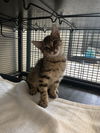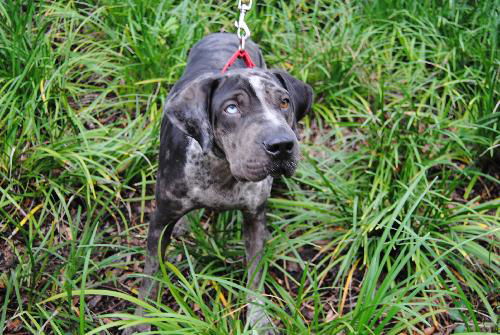
| My Rescue |
| Login to Remember your Favorite Animals and Breeds! |
Valentino came to us as a stray in some pretty bad shape! He was diagnosed with puppy mange but it is non-contagious and he has a clean bill of health. His hair still has some growing to do but is ready for his forever home! Here's what his previous foster family has to say about him:
- Very well socialized and gets along well with everyone and everything, including dogs, cats, children, ducks, even the goats!
- High energy level and needs a lot of room to run around and play - would be happiest in a home with a fenced yard
- Walks well on the leash and is crate trained and house trained
- Knows Sit, Shake, Get in Crate and plays fetch
- Loves to lay in your lap and sleep, or get a nice belly rub
- Very sweet personality and loves to get hugs and give kisses
- Very well behaved during bath time (should receive medicated baths weekly until his fur grows back in)
- Will overeat and overdrink, so food and water quantities must be managed
- Currently crated while left alone at home and does well when left alone
Foster Update: Val acclimated very well to his new home, though he would certainly be a lot happier with more room than an apartment. He enjoys looking out the window to keep up with the neighborhood, but will only ever (rarely) make a low woof sound. Val is a big lover and always excited when I get home. He prefers to stay beside me when we walk and does not pull very much despite his size. Characteristic of a Catahoula, his nose is almost always to the ground sniffing, or in the air sniffing. A great companion, Val is always a happy pup. After coming out of his too-loose collar on a walk, Val ran around excitedly and eventually ended up back at my front door waiting to play more. This dog always catches the attention of new people due to his unique looks, and they always comment that he has a great disposition
Foster Update: After just over 1 week together and good vibes from him, I took Val to the dog park knowing that he would be friendly with other dogs, come to me when called, and would LOVE to run around. Val got along well with all the other dogs and was interested in sniffing everything, and touching the water. He is still a little confused by the beach but is starting to understand that a lake is not just a big water bowl. One dog-owner noted that Val has the grey, wrinkly face of a manatee. Val doesn't quite realize how big he is, or his paws are, and sometimes bats at other dogs to get them to play with him. Also with the batting, Val will sometimes playfully growl and bark with other dogs and since he is a bigger pup this can seem scary when he is really just trying to rouse other dogs to play with him. Other than playtime, Val does not bark. I kept him at a boarder for 2 nights and they reported the same tendencies and characteristics as listed on his profile. Val does not always go to the bathroom when I take him out, but he also doesn't have accidents inside. He goes when he needs to go.
Foster Update: After a weekend at a friend's home, Val got along very well with an extremely energetic smaller pup who was constantly jumping on him to play and annoying him. Val just ignored the other dog and behaved extremely well, even as the other dog misbehaved in front of him. Even in an unfamiliar place, Val still held himself until we got outside to go to the bathroom. There was a low gate that he could have easily jumped over to sniff around the new place, but he just stayed put and waited until the people got back. He is so eager to please and make his humans happy with him. His short, almost patchy fur has proved to be amazing- he really doesn't shed- if anything, I clean the house before I even find any hair from him. He continues to keep up his good boy habits, and I continue to be amazed that he not yet found a forever home!
Note in picture- his paws are 'webbed' for better swimming, I suppose, but he has yet to have the opportunity to become acquainted with water, and swimming.
Like many dogs in the South, Valentino is heartworm positive, but don't let that stop you from adopting a great dog. We are treating him with monthly heartworm preventative, our preferred method. Many heartworm positive dogs go on to lead long and healthy lives.
PRBJtreats ALL of our dogs with monthly Heartworm preventative. Heartworms are transmitted to dogs via mosquitoes. Humans do not contract heartworms. Heartworm positive (HW+ ) dogs are treated with the recommended slow kill method, using monthly HW preventative as it is gentler on the animal’s system than the more invasive injection method. Most dogs that are Heartworm positive can lead healthy, normal lives if the worms are caught early and treatment began. There are different options to treat HW and new owners may choose to redirect their type of treatment with direction of their vet.All HW+ dogs have a HW slow treatment info sheet in their adoption folder which will be provided to new owners.
Are you familiar with the Shar-Pei breed? According to www.dogbreedinfo.com, the ancestry of the Shar-Pei is uncertain. It may be a descendant of the Chow Chow, however, the only clear link between these are the purple tongue. However, pictures on pottery suggest the breed was present even in the Han Dynasty (206bc). For many years the Shar-Pei was kept as a general-purpose farm dog in the Chinese countryside, used for hunting, protecting stock, and guarding the home and family. During that time the Shar-Pei was bred for intelligence, strength and scowling face. Later, it was used in dog fighting. The loose skin and extremely prickly coat were developed to aid the dog in fighting, making the Shar-Pei difficult for the opponent to grab and hold on to. During the Communist Revolution, dogs were rescued by a Hong Kong business man named Matgo Law, who appealed to Americans in 1973 though a dog magazine to save the breed. From those few specimens, the Shar-Pei fancy has grown tremendously over the past decades. The Shar-Pei is very loyal to his handler. It is an intelligent dog that does not always follow orders slavishly. Playful, active, dominant, and brave, they bond with their family, but are not unfriendly toward strangers. They make a delightful companion and good watchdogs. The Shar-Pei needs a confident handler. If you are too uncertain, too inconstant, too soft, or too mild in the dog's eyes, it will take over as the boss. These dogs are very clean and almost housebreak themselves. Famous for their wrinkles, Shar-Pei slowly loose their wrinkles as they get older. They generally hate water and try as hard as they can to avoid it. The Chinese Shar-Pei will do okay in an apartment if it is sufficiently exercised. It is moderately active indoors and will do okay without a yard. Because of their padded head, the Shar-Pei is very sensitive to heat. Shade and water must always be available. Provided they get enough exercise, they will be very peaceful indoors. They have a life expectancy of about 10 years.
Other Pictures of Valentino the Shar Pei (click to see larger version):
 23.3k |
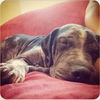 165.8k |
 63.2k |
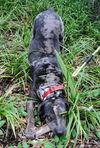 124.9k |
 64.1k |
 37.2k |
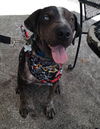 86.1k |
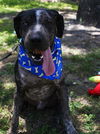 237.1k |
 84.3k |
 58k |
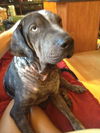 59.4k |
 31.7k |
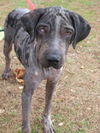 55.1k |
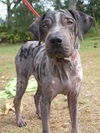 62.7k |
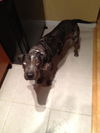 32.9k |
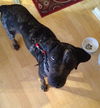 45.7k |
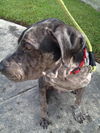 94.8k |
 59.3k |
 36.5k |
Copyright © Pet Rescue by Judy
